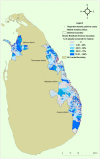Importance of active case detection in a malaria elimination programme
- PMID: 24885972
- PMCID: PMC4042136
- DOI: 10.1186/1475-2875-13-186
Importance of active case detection in a malaria elimination programme
Abstract
Background: With the aim of eliminating malaria from Sri Lanka by 2014, the Anti-Malaria Campaign of Sri Lanka (AMC) sought the support of Tropical and Environmental Disease and Health Associates Private Limited (TEDHA), a private sector organization. In 2009, TEDHA was assigned 43 government hospitals in the district of Mannar in the Northern Province and in districts of Trincomalee, Batticaloa and Ampara in the Eastern Province to carry out malaria surveillance to complement the surveillance activities of the AMC. Passive case detection (PCD), activated passive case detection (APCD) and active case detection (ACD) for malaria have been routinely carried out in Sri Lanka.
Methods: The active case detection programme of TEDHA involves screening of populations irrespective of the presence of fever or any other signs or symptoms of malaria to detect infections and residual parasite carriers. ACD is done by TEDHA in a) high risk populations through mobile malaria clinics including armed forces personnel and b) pregnant females who visit antenatal clinics for asymptomatic malaria infections during the first trimester of pregnancy. Populations are selected in consultation with the Regional Malaria Officer of the AMC thus avoiding any overlap with the population screened by the government.
Results: TEDHA screened 387,309 individuals in the four districts for malaria by ACD including high risk groups and pregnant women between January 2010 and December 2012. During this period seven individuals were diagnosed with Plasmodium vivax infections and one individual was detected with a mixed infection of P. vivax and Plasmodium falciparum. All eight cases were detected by ACD carried out by mobile malaria clinics among high risk groups in the Mannar district.
Conclusion: The progress made by Sri Lanka in the malaria elimination drive is largely due to increased surveillance and judicious use of control methods which has resulted in zero indigenous malaria cases being reported since October 2012. ACD played a major role in interrupting malaria transmission in the country.
Figures
Similar articles
-
Use of a public-private partnership in malaria elimination efforts in Sri Lanka; a case study.BMC Health Serv Res. 2018 Mar 23;18(1):202. doi: 10.1186/s12913-018-3008-y. BMC Health Serv Res. 2018. PMID: 29566691 Free PMC article.
-
Demonstration of indigenous malaria elimination through Track-Test-Treat-Track (T4) strategy in a Malaria Elimination Demonstration Project in Mandla, Madhya Pradesh.Malar J. 2020 Sep 17;19(1):339. doi: 10.1186/s12936-020-03402-6. Malar J. 2020. PMID: 32943065 Free PMC article.
-
Effectiveness of a serological tool to predict malaria transmission intensity in an elimination setting.BMC Infect Dis. 2017 Jan 9;17(1):49. doi: 10.1186/s12879-016-2164-0. BMC Infect Dis. 2017. PMID: 28068925 Free PMC article.
-
Technical and operational underpinnings of malaria elimination from Sri Lanka.Malar J. 2019 Jul 29;18(1):256. doi: 10.1186/s12936-019-2886-8. Malar J. 2019. PMID: 31358007 Free PMC article. Review.
-
Ready for malaria elimination: zero indigenous case reported in the People's Republic of China.Malar J. 2018 Aug 29;17(1):315. doi: 10.1186/s12936-018-2444-9. Malar J. 2018. PMID: 30157876 Free PMC article. Review.
Cited by
-
Active v. passive surveillance for malaria in remote tribal belt of Central India: Implications for malaria elimination.Pathog Glob Health. 2016 Jun-Jul;110(4-5):178-84. doi: 10.1080/20477724.2016.1223920. Epub 2016 Sep 1. Pathog Glob Health. 2016. PMID: 27585412 Free PMC article.
-
Evaluation of the operational challenges in implementing reactive screen-and-treat and implications of reactive case detection strategies for malaria elimination in a region of low transmission in southern Zambia.Malar J. 2016 Aug 15;15(1):412. doi: 10.1186/s12936-016-1460-x. Malar J. 2016. PMID: 27527347 Free PMC article.
-
PET-PCR reveals low parasitaemia and submicroscopic malarial infections in Honduran Moskitia.Malar J. 2023 Mar 28;22(1):110. doi: 10.1186/s12936-023-04538-x. Malar J. 2023. PMID: 36978056 Free PMC article.
-
Reactive case-detection of malaria in Pailin Province, Western Cambodia: lessons from a year-long evaluation in a pre-elimination setting.Malar J. 2016 Mar 1;15:132. doi: 10.1186/s12936-016-1191-z. Malar J. 2016. PMID: 26931488 Free PMC article.
-
Characterizing the spatial distribution of multiple malaria diagnostic endpoints in a low-transmission setting in Lao PDR.Front Med (Lausanne). 2022 Aug 18;9:929366. doi: 10.3389/fmed.2022.929366. eCollection 2022. Front Med (Lausanne). 2022. PMID: 36059850 Free PMC article.
References
-
- World Health Organization. World Malaria Report. Geneva: World Health Organization; 2013. p. 2013.
-
- Malaria Elimination. A field manual for low and moderate endemic countries. [ http://whqlibdoc.who.int/publications/2007/9789241596084_eng.pdf]
-
- World Health Organization. T3: Test. Treat. Track initiative. Geneva: World Health Organization; 2012.
-
- Edirisinghe JS. Malaria, the scourge of the tropics. Historical references to malaria in Sri Lanka and some notable episodes up to present times. Ceylon Med J. 1988;33:143–150. - PubMed
Publication types
MeSH terms
LinkOut - more resources
Full Text Sources
Other Literature Sources


